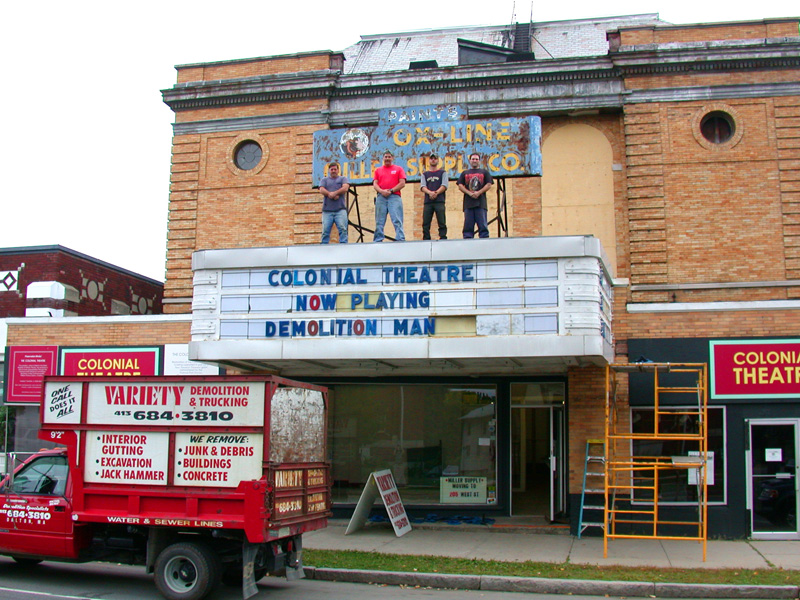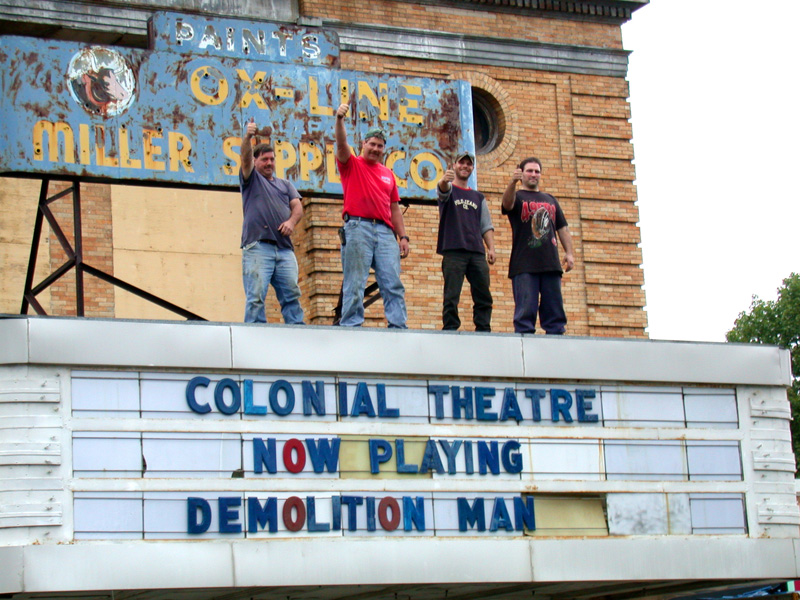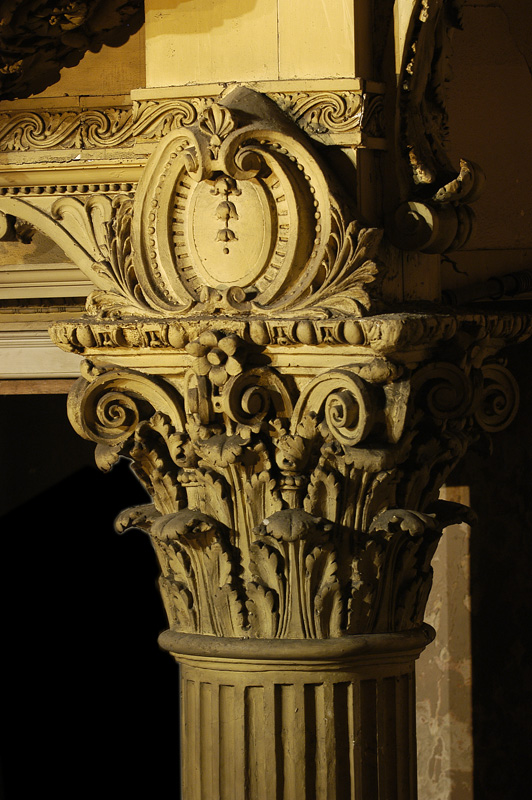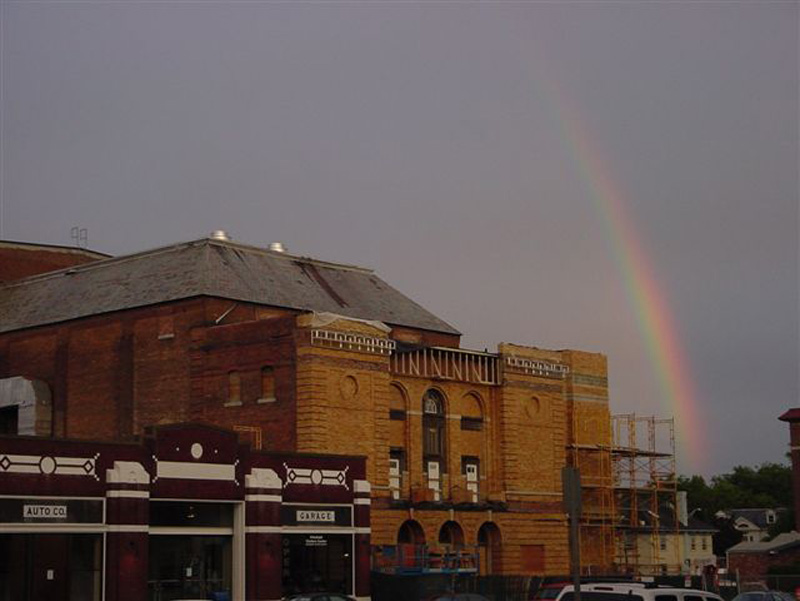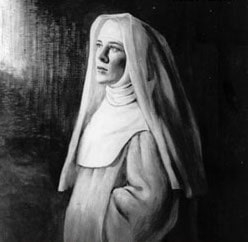
The interior of the beautiful Colonial Theatre.
The Colonial Theatre is one of America’s finest turn-of-the-century theatres to survive intact!
Designed by the noted firm of theatre architects, J. B. McElfatrick, the Colonial Theatre’s stage and audience chamber were a class above most playhouses of the day. McElfatrick designed hundreds of theatres throughout North America during the latter half of the 19th and first few years of the 20th centuries – upwards of 51 in New York City alone – but the Colonial is one of only a handful still standing.
McElfatrick was engaged by the Sullivan family of North Adams to build the Empire Theatre in that community. The Sullivans later erected the Colonial in Pittsfield utilizing the same designs. We marvel today at the fact that The Colonial Theatre was built in only 5 ½ months at a cost of $70,000 in 1903, but that was actually typical at that time. Unfortunately, the Empire Theatre burned to the ground in 1912 (a frequent fate of theatres in that day).
As was sometimes the custom in that day, the exterior of the theatre was designed by a respected local architect, Joseph McArthur Vance, who also designed Pittsfield’s Masonic Temple, the Christian Science building, the superstructure of the Wahconah Park Stadium, Mount Greylock’s Bascom Lodge, and the Mahaiwe Theatre in Great Barrington.
Over the proscenium arch, in a “sail vault”, is a sounding board decorated by a mural representing Art and Music. The proportions of the theatre, the sounding board, the curved room elements, and the articulated plaster detail are design signatures of J.B. McElfatrick and are thought to contribute to the superior natural acoustics of the theatre.
More Details
The Colonial Theatre opened on September 28, 1903 with a production of the operetta Robin Hood by the Bostonians, a famed touring group. The house was sold out.
The Colonial soon became a regular stop for big-name entertainers, including:
- Actress Maude Adams (4 times)
- Acting siblings John and Ethel Barrymore (multiple times)
- Actress Sarah Bernhardt (twice)
- Jazz pianist Eubie Blake (twice)
- Playwright/Song & Dance man George M. Cohan
- Max Fiedler and the Boston Symphony Orchestra
- Pianist Ignace Jan Paderewski
- Prima Ballerina Anna Pavlova
- Composer and pianist Sergei Rachmaninoff
- Humorist Will Rogers
- March King John Philip Sousa and his band (4 times)
- Ziegfeld Follies 1928 tour with a cast of 100, including the Rockettes
 The perfect proportions of the Colonial Theatre were enhanced with intricate plaster work and rich finishes and, after extensive renovations in 1912, state-of-the-art theatrical technology – electric footlights, border lights and a switchboard by the General Electric Company.
The perfect proportions of the Colonial Theatre were enhanced with intricate plaster work and rich finishes and, after extensive renovations in 1912, state-of-the-art theatrical technology – electric footlights, border lights and a switchboard by the General Electric Company.
In 1934, the Colonial ended its years as a nationally revered playhouse and largely closed its doors due to the economic strain of the Depression.
In 1937, the Colonial reopened with a new marquee, projection room, and two retail stores having been added to the front of the building, dramatically altering its classic lines. It operated primarily as a movie theatre, although some community performances continued until the day the theatre closed.
On December 31, 1952, the Colonial, no longer functioning as a theatre, was purchased by George and Sally Ruth Miller, who moved their business into what had been the orchestra level. To accommodate a retail paint and art supply business, the orchestra floor was leveled and a drop ceiling was added, concealing – and preserving – the balconies and elaborate architectural details. The Miller family is credited by all associated with the theatre for maintaining the structural and decorative integrity of The Colonial Theatre until the community was ready to bring it back into service as a community entertainment center.
In 1997, public tours of the theatre led to increased community awareness of its potential. Then State Senator Andrea F. Nuciforo, Jr. of Pittsfield announced that the pending Commonwealth of Massachusetts Convention Center Bond Bill included $2.5 million in funding for The Colonial Theatre Restoration Project. Subsequent regular public tours of the building were scheduled by the Friends of The Colonial Theatre Restoration, Inc. and public sentiment about the value of the project to Pittsfield began to grow.
In 1998, after many years of effort by the Friends of The Colonial Theatre Restoration, Inc. to have the theatre’s historic significance recognized by the community and the nation, The Colonial Theatre was designated a National Historic Treasure by the Save America’s Treasures Program of the National Park Service. Reinforced by a visit to Pittsfield by then First Lady Hillary Clinton, this designation provided national credibility to the plan to restore and operate The Colonial Theatre. Senator Nuciforo continued to secure additional Commonwealth support for the project as others built local momentum and plans for the theatre.
 In 2001, the theatre was purchased from the Miller Family and The Colonial Theatre Association began the process of restoration by removing the temporary walls and ceilings and having the layers of paint analyzed to confirm that the original ornamentation matched its description in news reports from its 1903 opening. After years of design, planning, and community fundraising, the rehabilitation of the historic Colonial Theatre and the extensive renovation of the adjacent Berkshire Auto Garage were undertaken.
In 2001, the theatre was purchased from the Miller Family and The Colonial Theatre Association began the process of restoration by removing the temporary walls and ceilings and having the layers of paint analyzed to confirm that the original ornamentation matched its description in news reports from its 1903 opening. After years of design, planning, and community fundraising, the rehabilitation of the historic Colonial Theatre and the extensive renovation of the adjacent Berkshire Auto Garage were undertaken.
In August 2006, the theatre reopened to the public. The twenty-two-month construction process preserved and reinstalled all historically significant architectural and design features while creating a modern performance center equipped to handle the needs of artists and audiences alike. Audiences were awed by the vaulted gilded entrance, the elaborately decorated boxes and balcony, the meticulously crafted custom plasterwork, and the exquisitely painted ornamental detail. The upper Gallery level preserved the original rare high-backed “pew” seating from which the view of the original “sail vault” over the proscenium, complete with its restored central mural featuring the muses of art and music, could once again inspire all who saw it.
In subsequent years, the Colonial has enhanced the learning experience for tens of thousands of area school children, has served hundreds of thousands of visitors, generated millions annually in community economic impact, and has fulfilled or surpassed the expectations most people in the Berkshires had when the struggle to restore The Colonial Theatre got underway.
About J.B. McElfatrick
Born near Harrisburg, PA in 1824, John B. McElfatrick, aided by his two sons at various times during his career, designed the sight lines and acoustic plans upon which many American theatres were built. In New York City, he designed the Abbey (later the Knickerbocker ) Theatre Building, the New York and Criterion Theatres (both part of Oscar Hammerstein’s sprawling Olympia entertainment complex in Times Square), Empire, Theatre Republic, Broadway, Alhambra, Murray Hill, Metropolis and Hudson Theatres, the Harlem Opera House, and F. F. Proctor’s Pleasure Palace. He also directed the redesign and reconstruction of the Metropolitan Opera House after it was gutted by fire in 1892. Of these, only the Theatre Republic (now the New Victory Theatre) and the Hudson are still standing.
The preeminent American theatre architects of their time, the prolific McElfatricks also designed the National Theatre in Washington D.C. and Hammerstein’s (later the Metropolitan) Opera House of Philadelphia (the largest in the world at the time it was built) among hundreds of others across the country.
John B. McElfatrick died in 1906 at the age of 81, still at work on plans for new theatres.














